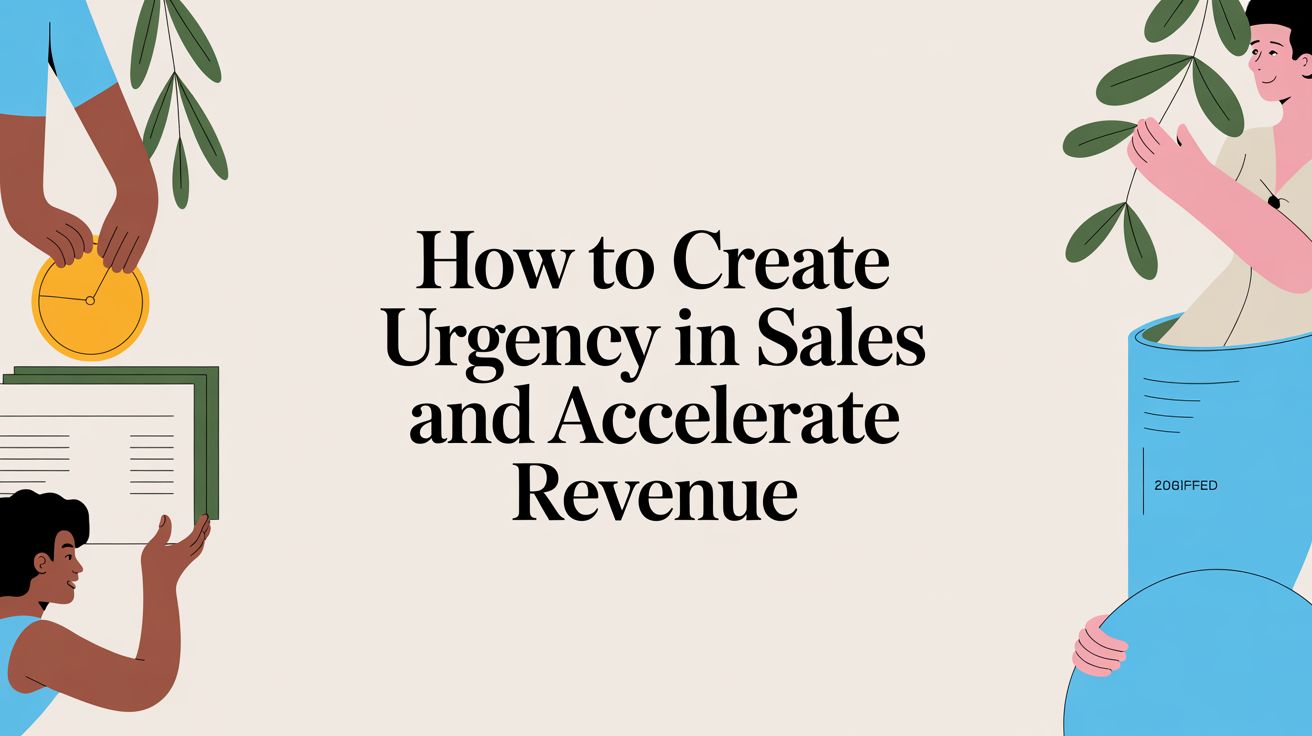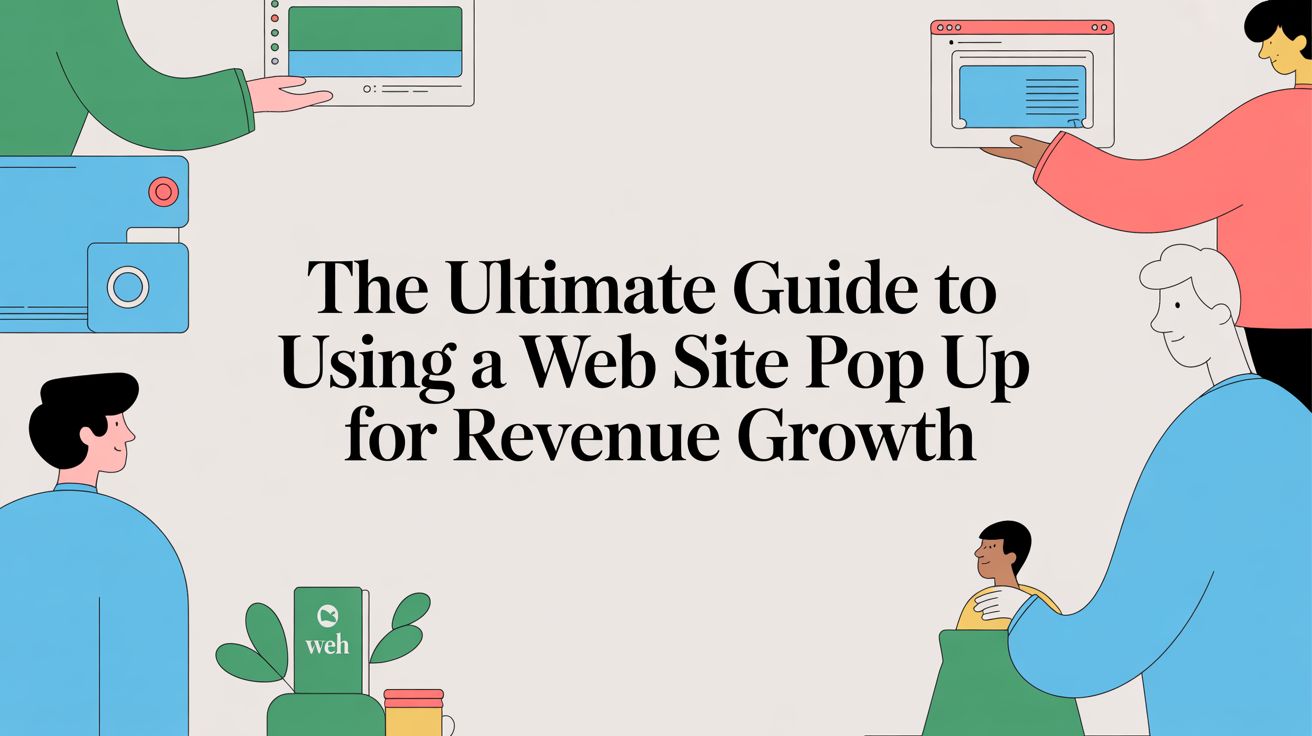
Master Cart Abandonment Shopify Strategies to Boost Sales
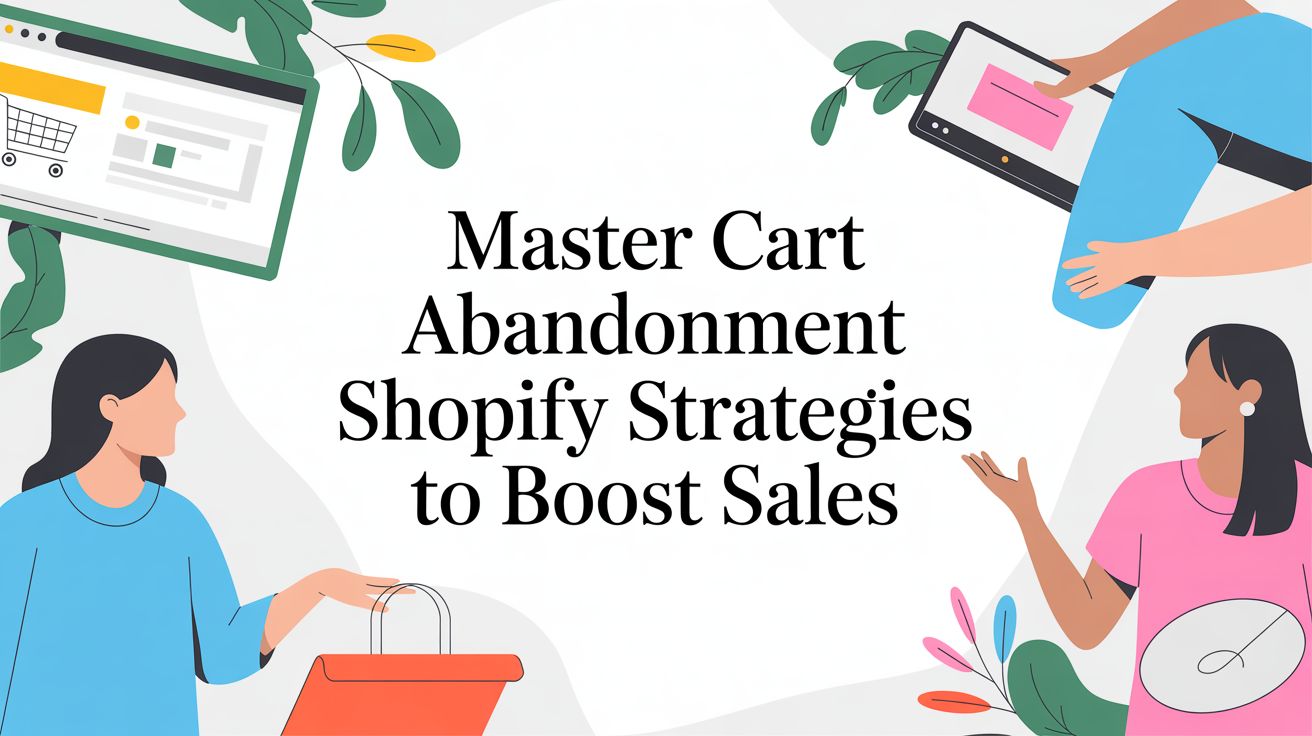
Tackling cart abandonment on Shopify requires looking past surface-level fixes and digging into the behavioral psychology of why a customer clicks away at the last second.
For Shopify store owners, the industry benchmark 70% cart abandonment rate is not just a statistic; it represents the single largest source of untapped revenue. Recovering even a fraction of these sales can directly impact your bottom line.
Unlocking Revenue from Abandoned Shopify Carts
The scale of this challenge is significant. For every ten shoppers who add an item to their cart, seven will leave without buying. This isn't just a lost sale; it's a clear signal of high purchase intent that faltered at the final step.
Across numerous studies, the average cart abandonment rate is 70.22%. For Shopify merchants, that figure is often slightly higher. You can review detailed cart abandonment benchmarks here to see how the numbers stack up across different devices and industries.
The key to winning these customers back is not by offering aggressive, margin-killing discounts. It's about understanding and addressing the psychological roadblocks that caused them to hesitate in the first place.
Moving Beyond Surface-Level Fixes
Many Shopify merchants react to abandonment by treating symptoms, not the cause. They might send a generic 10% off coupon or place a basic countdown timer on a product page. While these tactics can provide a minor lift, they rarely deliver significant ROI because they ignore the underlying behavioral science.
To illustrate, let's break down the disconnect between common problems and the deeper psychological triggers behind them. Most standard "fixes" are temporary patches that fail to address the core issue.
Psychological Drivers vs Standard Cart Abandonment Fixes
| Abandonment Reason | Underlying Psychology | Standard (Ineffective) Fix | Advanced (Effective) Strategy |
|---|---|---|---|
| Unexpected Shipping Costs | Loss Aversion: The pain of an unforeseen fee feels worse than the joy of the product. | Show shipping costs only at the final checkout step. | Implement a free shipping threshold ("Free shipping on orders over $50!"). |
| "Just Browsing" / Comparison | Decision Paralysis: Overwhelmed by options or uncertainty about the "best" choice. | Send a generic "You left something in your cart" email. | Use social proof ("25 others bought this today") and scarcity ("Only 3 left!"). |
| Complex Checkout Process | Cognitive Overload: Too many steps or form fields create mental friction and fatigue. | Require account creation and all information upfront. | Offer guest checkout and a multi-step progress bar to manage expectations. |
| Security/Trust Concerns | Fear & Uncertainty: Doubts about payment security or brand legitimacy. | Simply display credit card logos in the footer. | Prominently feature trust badges, security seals, and customer reviews. |
The advanced strategies don't just solve a logistical problem; they address a psychological one. They build confidence and reframe the decision to buy as not just safe, but intelligent.
A Psychology-Driven Approach to Recovery
An effective strategy reframes the problem entirely. An abandoned cart is a high-intent lead. The shopper has explicitly told you what they want. Your role is to provide a compelling, psychologically-sound reason for them to complete the purchase now.
This is where the science of urgency marketing, expertly applied through tools like Quikly, excels. It is not about creating artificial pressure, but about tapping into the natural human wiring that drives decision-making.
By understanding principles like scarcity, social proof, and anticipation, you can build a customer journey that encourages decisive action. The goal is to transform hesitation into confidence, making the choice to buy feel both easy and intelligent.
This entire approach is built around protecting your ROI and profit margins. Instead of defaulting to margin-killing discounts, you use powerful behavioral triggers to increase the perceived value of completing the purchase.
For example, showing that an item is low in stock (scarcity) or that other people are buying it right now (social proof) directly counters the fear of missing out (FOMO) without devaluing your brand.
Ultimately, solving the cart abandonment puzzle represents your store's biggest growth opportunity. It’s a direct path to increasing revenue from the traffic you already have. By shifting from reactive fixes to a proactive, psychology-based strategy, you can turn abandoned carts into your most consistent and profitable revenue stream.
Diagnosing Your Store’s Abandonment Hotspots
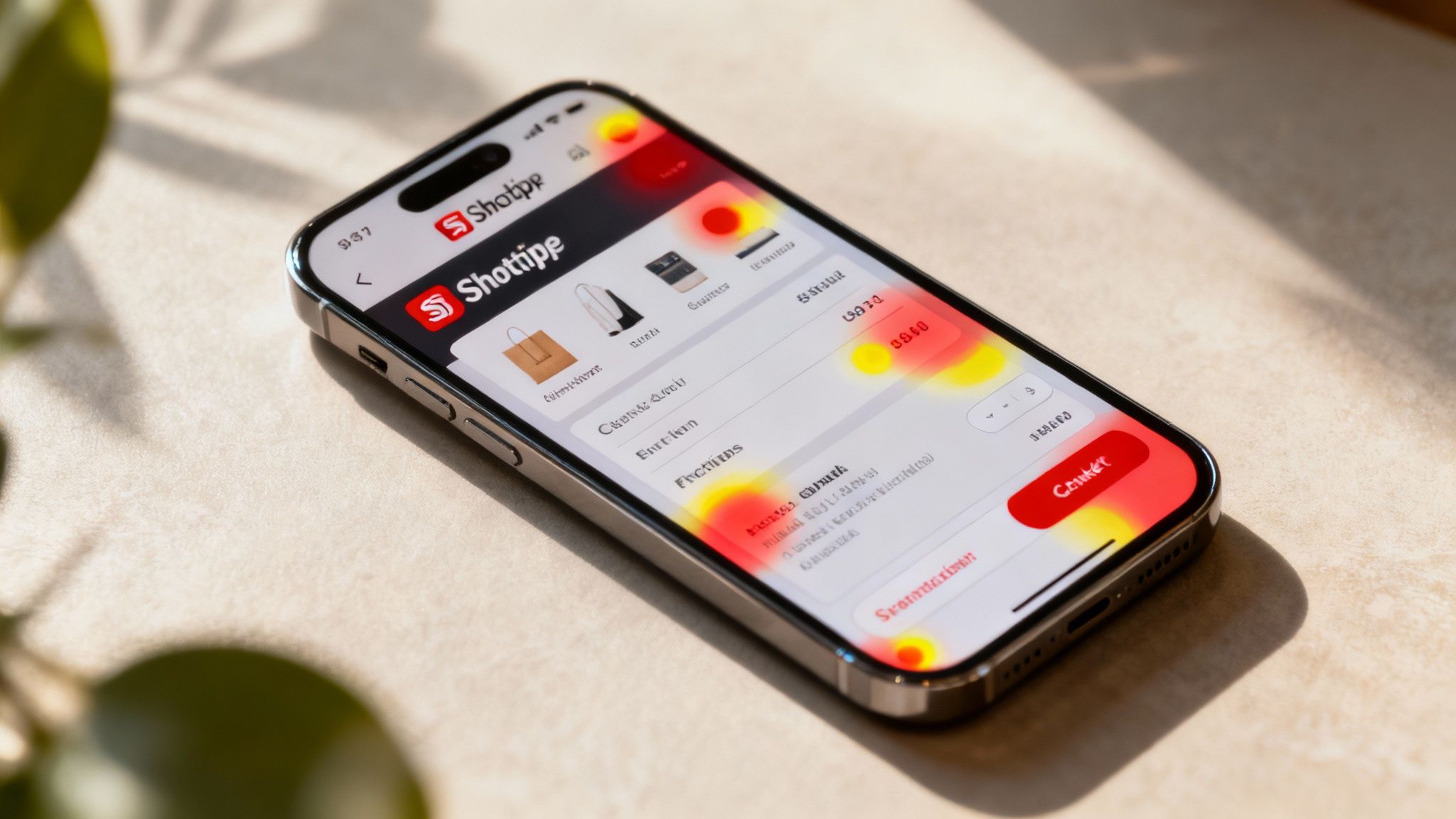
To meaningfully reduce cart abandonment on your Shopify store, you must begin with data-driven diagnosis. Guesswork leads to wasted time and resources. A methodical analysis of your checkout process is required to pinpoint the exact friction points—the "hotspots"—where potential customers abandon their journey.
This data-first approach is the foundation of any effective recovery strategy.
Start with the tools you likely already use. Shopify Analytics provides a high-level view of your conversion funnel, tracking the customer journey from adding an item to their cart, initiating checkout, and completing a purchase. This will quickly reveal where your biggest drop-offs occur.
Diving Deeper with Google Analytics
For a more granular analysis, Google Analytics is indispensable. Setting up a goal funnel for your checkout process allows you to visualize step-by-step drop-off rates. You may discover that a significant percentage of users abandon the process after entering shipping information but before reaching payment options.
This insight is invaluable.
The problem shifts from a vague "people are leaving" to a specific, solvable question: "Why are people abandoning at the shipping stage?"
The screenshot above illustrates what this funnel looks like in Google Analytics. Each bar represents a step in your checkout, and the drop-off between them highlights a problem area. By understanding this, you can focus your efforts on the steps with the highest abandonment rates for maximum business impact.
Seeing Through Your Customers' Eyes
Analytics reveal what is happening, but they don't always explain why. Qualitative tools like heatmaps and session recordings provide that context. Heatmaps show where users click, move, and scroll, revealing which parts of your checkout page are being ignored or causing confusion.
Session recordings allow you to watch anonymized videos of real user sessions. You might observe a user repeatedly tapping a non-clickable element or struggling to find the discount code field on a mobile device. Witnessing user frustration firsthand is one of the fastest ways to identify and fix usability issues that are costing you sales.
Identifying checkout friction is not just about finding flaws; it's about understanding the psychological state of your shopper at a critical moment. A confusing form or an unexpected fee creates cognitive dissonance, disrupting the smooth journey from "I want this" to "it's mine."
A primary cause of abandonment is unexpected shipping costs revealed at the end of the process. This surprise fee triggers loss aversion, which can easily overpower the excitement of the purchase. This is where it pays to explore strategies for finding cost-effective shipping solutions to enable greater transparency and appeal.
The Critical Mobile Experience
The need for a frictionless experience is amplified on mobile devices, which consistently show the highest abandonment rates. Mobile cart abandonment hovers around 77.08%, a stark contrast to the 62.04% on desktops.
This data underscores a non-negotiable truth: your checkout must be mobile-first. Common friction points on mobile include:
- Difficult Form Fields: Small text and cumbersome typing on a small screen.
- Forced Account Creation: A significant barrier for new customers seeking a quick purchase.
- Non-Optimized Payment Options: Lack of express checkout options like Apple Pay or Google Pay.
- Slow Page Load Times: Every second counts; a slow mobile experience is a direct cause of abandonment.
By combining quantitative data from Shopify and Google Analytics with qualitative insights from user behavior tools, you can create a comprehensive map of your abandonment hotspots. This approach replaces assumptions with evidence, enabling targeted, psychology-backed solutions that address the real reasons shoppers are leaving.
Using Urgency Psychology to Prevent Abandonment
The most profitable approach to cart abandonment on Shopify is to prevent it from happening in the first place. Instead of solely relying on recovery emails to chase lost sales, a proactive strategy creates a psychologically-backed reason for shoppers to complete their purchase immediately. This is the domain of sophisticated urgency marketing, which extends far beyond basic countdown timers.
Effective urgency is not manipulation. It is the application of behavioral science to tap into the fundamental triggers that guide human decision-making, providing a high-intent shopper with the context needed to confidently convert. When implemented correctly, your Shopify store transforms from a static catalog into a dynamic, compelling buying environment.
The Core Principles of Urgency Marketing
This approach is grounded in established principles of behavioral economics. People are innately wired to respond to certain cues, and you can ethically leverage these on your Shopify store to encourage action and protect revenue.
The most powerful principles include:
- Scarcity: The classic "low stock" alert. When a shopper perceives that a product is limited, its value increases due to our natural instinct to avoid loss.
- Social Proof: People are influenced by the actions of others. Messages like "27 people have this in their cart" or "Just purchased in New York, NY" serve as powerful validators, reducing a shopper's hesitation.
- FOMO (Fear of Missing Out): A primary motivator, FOMO is driven by potential regret. Highlighting a limited-time offer, an expiring deal, or a special edition product makes the cost of inaction feel greater than the cost of the item itself.
- Anticipation: Building excitement for a future event, such as a new product launch or a flash sale, primes customers to convert the moment the event begins.
A modern Shopify storefront is the perfect canvas for integrating these psychological triggers seamlessly.
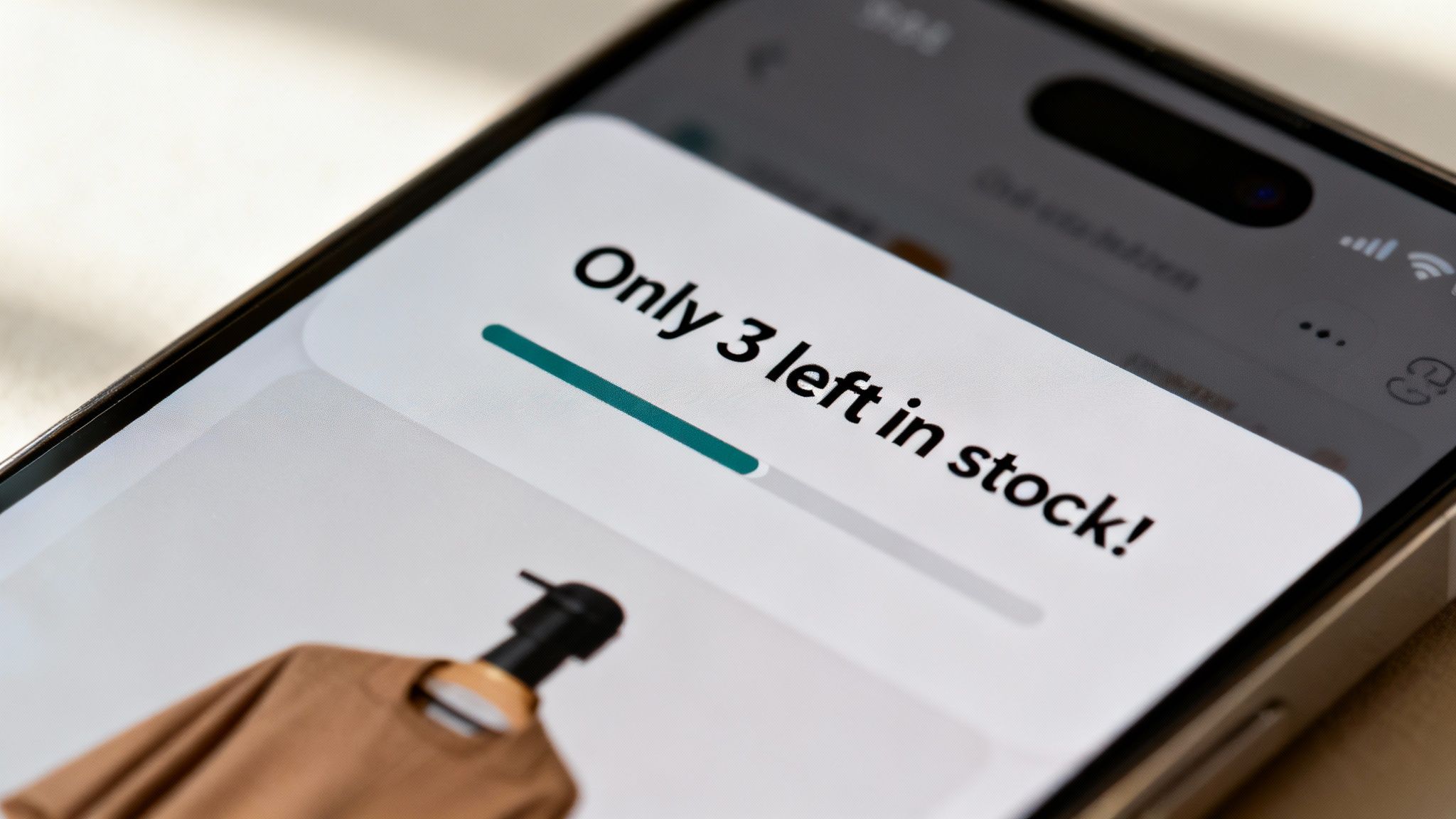
The clean layout allows for the addition of dynamic elements like urgency banners or social proof notifications that feel like a natural and helpful part of the shopping experience.
Putting Urgency into Practice on Shopify
The key is to move beyond basic timer apps, which often focus on email capture rather than driving immediate sales revenue. Advanced urgency marketing platforms, like Quikly, enable you to use sophisticated automation to integrate urgency directly into the shopper's journey.
Instead of a generic timer on every page, you can implement intelligent behavioral triggers. For example, a dynamic banner announcing a limited-time free shipping offer could appear only after a user adds an item to their cart. This feels like a personalized reward, not a pressure tactic. Quikly positions these "Moments" as the next generation of urgency marketing, enhancing the entire journey.
The goal of modern urgency marketing is to enhance the customer experience, not detract from it. By presenting time-sensitive information in a helpful context, you assist the customer in their decision-making process, turning a moment of hesitation into a moment of conversion.
This approach also protects your profit margins by reducing reliance on post-abandonment discounts. Why offer 15% off in an email tomorrow when a well-placed social proof notification can secure the full-price sale today?
Advanced Applications for Shopify Plus
For enterprise brands on Shopify Plus, this strategy can be implemented with even greater precision by integrating urgency with your CRM and inventory data.
Imagine showing a low-stock warning only to shoppers in a specific geographic region where warehouse inventory is genuinely low. Or, create an exclusive, time-sensitive offer that only appears for your top-tier VIP customers upon login. This level of personalization makes the urgency feel completely authentic and relevant.
These strategies integrate seamlessly with your marketing stack. You can synchronize on-site urgency "Moments" with campaigns running in Klaviyo or your SMS platform, creating a powerful, consistent message across all channels. For merchants ready to elevate their on-site experience, learning more about advanced Shopify urgency tactics is the clear next step.
By embracing the psychology behind urgency, you shift your focus from recovering lost sales to preventing them. It’s a proactive strategy that not only boosts your conversion rate but also directly grows your revenue and protects your bottom line.
Building Your Automated Cart Recovery Engine
Even with the best on-site prevention strategies, some shoppers will abandon their carts. A robust, automated recovery system is therefore essential, working 24/7 to recapture that lost revenue.
If you are currently relying on Shopify's single, default reminder email, it is time for an upgrade. The goal is to build a powerful, multi-channel engine that delivers a measurable impact on your ROI.
An effective recovery sequence is not a single, generic email. It is a carefully timed conversation across multiple channels—primarily email and SMS—that gently guides the hesitant shopper back to their cart.
Architecting a Multi-Channel Flow
The core of a strong recovery engine is a well-designed sequence that maps out the timing, channel, and message for each touchpoint. The objective is to increase the psychological appeal over time without being intrusive.
Here is a proven structure you can implement immediately:
- 1 Hour After Abandonment (Email): The first touchpoint should be a gentle, helpful reminder. The shopper's intent is still warm. A simple message like, "Did you forget something?" or "Your items are waiting for you" is effective. This is not the time for a hard sell or a discount.
- 24 Hours After Abandonment (Email): Now, you can introduce more powerful psychological triggers. This follow-up is the perfect place to integrate social proof ("Join thousands of happy customers") or customer reviews for the specific items in their cart. This builds confidence and addresses uncertainty.
- 48 Hours After Abandonment (SMS): A text message feels more direct and immediate, so it should be used strategically to command attention. This is the ideal moment to introduce a small, time-sensitive incentive. A message like, "Your cart expires soon! Use code SAVE10 for 10% off in the next 3 hours" creates a clear, compelling reason to act now.
This multi-step approach is far more effective than a single email because it adapts to the customer's cooling intent by layering on more persuasive elements over time.
This infographic provides a visual representation of how this timeline works.
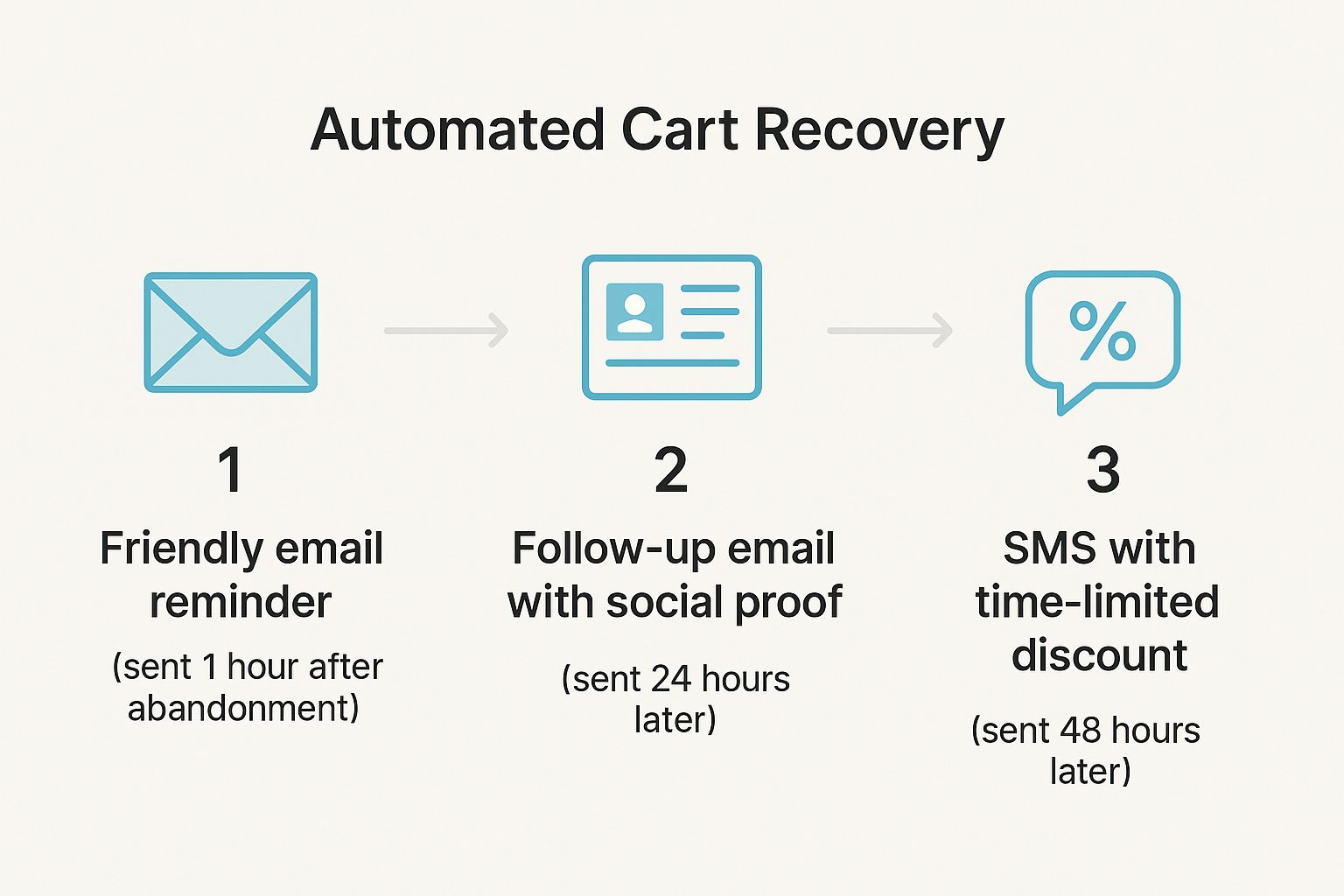
Escalating the urgency and value over a 48-hour period is a highly effective way to recapture attention and complete the sale.
To provide a clearer picture, here's how a multi-channel flow could be structured.
Sample Multi-Channel Cart Recovery Sequence
| Time After Abandonment | Channel | Content Focus | Psychological Principle |
|---|---|---|---|
| 1 Hour | Gentle "Did you forget?" reminder with cart link | Zeigarnik Effect | |
| 12 Hours | Social proof (customer reviews, best-seller callout) | Social Proof | |
| 24 Hours | Address common objections (FAQs, shipping info) | Building Trust | |
| 48 Hours | SMS | Time-sensitive discount (e.g., 10% off for 3 hrs) | Urgency & Scarcity |
This layered approach meets the customer where they are, gradually overcoming their hesitation without being overwhelming.
Integrating With Your Shopify Tech Stack
To build this engine, you need tools that integrate seamlessly with your Shopify store. Platforms like Klaviyo are the industry standard for creating sophisticated email and SMS automation. They allow for granular segmentation based on cart value, purchase history, and other behaviors to send hyper-relevant recovery messages.
These tools feature visual builders, making it easy to map out complex, multi-branch recovery sequences without writing code. This empowers you to continuously test different timings, messages, and offers to optimize performance.
An automated recovery engine is more than a safety net; it's a revenue-generating machine. By turning abandoned carts into completed orders, you directly increase sales from traffic you've already acquired, dramatically boosting the ROI of your marketing spend.
It's also important to remember how this engine fits into your broader strategy. Recovery sequences are powerful but reactive. They work best when paired with proactive tools that prevent abandonment in the first place. You can learn more about how to strategically use popups on Shopify to capture a visitor's attention before they bounce.
Beyond Basic Triggers
For Shopify Plus merchants, the opportunities for sophisticated automation are even greater. You can integrate your recovery engine directly with your inventory management system to create real scarcity. Imagine an automated email that only triggers when an item in a cart drops below ten units in stock. This is not artificial urgency; it is a powerful and genuine incentive to buy now.
You can also connect your recovery flows to your loyalty program, offering a higher-value incentive to a VIP customer who abandons a cart. This level of personalization makes your outreach feel less like generic marketing and more like a valuable, white-glove service.
By investing the time to build a smart, multi-channel recovery engine, you create a system that not only saves lost sales but also strengthens customer relationships, turning hesitation into profitable conversions.
Measuring Success Beyond the Conversion Rate
It is easy to develop tunnel vision and judge your Shopify cart abandonment strategy solely by the conversion rate. However, a rising conversion rate does not automatically indicate a healthier business. If you are constantly slashing prices and offering large discounts to recover carts, you may be increasing sales while eroding your profit margins.
To determine if your efforts are building a stronger, more sustainable business, you must look deeper. The true measure of success lies not in simple percentages, but in metrics that reflect tangible business impact, such as revenue, profitability, and customer value.
Key Metrics for True Business Impact
Instead of focusing on a single conversion metric, a balanced scorecard of KPIs provides a comprehensive view of your recovery engine's performance. This ensures you are not sacrificing long-term health for short-term gains.
The metrics that truly matter are:
- Recovered Revenue: This is the most direct measure. How much actual revenue are your automated emails, SMS messages, and on-site urgency tactics generating? Track this weekly and monthly to see the real ROI.
- Average Recovered Order Value (AOV): Are the carts you are saving filled with high-margin best-sellers or clearance items? A healthy recovered AOV indicates you are bringing back valuable customers, not just bargain hunters.
- Return on Investment (ROI): This is your ultimate bottom-line metric. Calculate it by taking the total recovered revenue and subtracting the cost of your tools (email/SMS platform, apps) and any discounts offered. A strong ROI confirms your strategy is profitable.
- Customer Lifetime Value (CLV): Do shoppers recovered from an abandoned cart make repeat purchases? Tracking the CLV of this specific cohort is crucial. An effective recovery strategy doesn't just secure one sale; it creates a loyal, repeat customer.
Shifting your focus to these metrics means you stop simply "fixing" abandoned carts and start strategically building a more profitable business.
The best cart recovery strategies don’t just claw back a single sale—they protect your profit margins and build long-term customer relationships. Measuring success with metrics like ROI and CLV ensures your tactics are actually driving sustainable growth, not just vanity numbers.
Analyzing Profitability and Protecting Margins
Discounts are a double-edged sword in any recovery sequence. While effective, they can erode margins if not used carefully. The goal is to find the minimum effective dose of discounting—just enough to secure the sale without devaluing your brand.
This is where A/B testing is critical. Test a 10% off offer against a free shipping incentive. You may find that while the 10% discount converts slightly better, the free shipping offer protects your margins more effectively, leading to a higher net profit per recovered order. For many store owners, a key goal is improving conversion rates with automation, and this type of intelligent testing is how you achieve it.
The Hidden Benefit for Inventory Management
A well-measured recovery strategy also provides a significant benefit for inventory management.
When you can accurately predict how much revenue you'll recover from abandoned carts containing specific products, you can make smarter purchasing decisions. This is particularly valuable for Shopify Plus merchants with large catalogs. If you know your urgency tactics and recovery emails are especially effective at selling a certain product line, you can stock up with confidence, prevent stockouts, and fully capitalize on that demand. Your marketing data becomes a powerful strategic intelligence tool.
Ultimately, analyzing these advanced metrics empowers you to make smarter, data-backed decisions. To go deeper, see our guide on how to measure marketing campaign effectiveness for a complete framework.
Shopify Cart Abandonment Questions Answered
When implementing strategies to reduce cart abandonment on Shopify, questions are inevitable. Getting clear answers is essential for building the confidence to execute these tactics effectively.
Let's address some of the most common questions from merchants, focusing on what truly drives results.
What Is the Most Effective First Step for a New Store?
For a new store, the single most effective first step is to set up a basic, automated cart recovery email sequence. This acts as your foundational safety net, working 24/7 to bring back shoppers who were moments away from purchasing.
Before investing in advanced on-site tools, get this in place.
Your initial sequence can be simple. A two-step flow is a perfect starting point:
- Email 1 (Sent 1-4 hours after abandonment): A friendly, no-pressure reminder. The goal is to catch them while their buying intent is still high and guide them back to their cart.
- Email 2 (Sent 24 hours after abandonment): Add a gentle nudge with social proof, such as highlighting customer reviews for the items they left behind to build confidence.
This simple setup delivers an immediate ROI by recovering revenue you would otherwise lose and provides a solid baseline for future optimization.
Are Discounts the Best Incentive to Recover Carts?
While discounts can be effective, they are rarely the best long-term solution. They can erode profit margins and, over time, devalue your brand's image.
Many shoppers abandon carts for reasons unrelated to price—distractions, technical glitches, or life interruptions. Offering a discount to every abandoner is an expensive solution for a problem that may not be price-related.
Behavioral economics tells us that psychological triggers often pack a bigger punch than a small discount. Things like scarcity ("Only 3 left in stock!") or social proof ("25 others bought this today!") can be way more powerful. These tactics actually increase the product's perceived value instead of just lowering its price.
Before defaulting to promo codes, test non-monetary incentives. Free shipping, for example, is often a more profitable alternative because it directly addresses one of the primary reasons for abandonment without devaluing your product.
How Can I Use Urgency Ethically?
Using urgency ethically is centered on one principle: authenticity. The goal is not to create false pressure but to provide customers with truthful, helpful information that facilitates their decision-making process.
- Real Scarcity: Low-stock warnings should always be based on actual inventory levels. Integrating your urgency tool directly with your Shopify inventory ensures these messages are always accurate.
- Genuine Deadlines: If you announce a flash sale, the end time must be firm. Consistently extending sales trains your customers to ignore your deadlines.
- Helpful Social Proof: Display real, live data about how many people are viewing an item or have recently purchased it. This is not manipulation; it is valuable social context that helps shoppers feel more confident in their choice.
When your strategy is grounded in real data and transparency, urgency becomes a customer service tool. It creates a more responsive and helpful shopping experience, moving beyond a simple countdown timer and into the sophisticated application of consumer psychology.
Ready to transform cart abandonment from a problem into your biggest revenue driver? Quikly provides the advanced urgency marketing tools to prevent abandonment before it happens and recover sales with psychologically-backed strategies. Discover how Quikly can boost your Shopify sales today.

The Quikly Content Team brings together urgency marketing experts, consumer psychologists, and data analysts who've helped power promotional campaigns since 2012. Drawing from our platform's 70M+ consumer interactions and thousands of successful campaigns, we share evidence-based insights that help brands create promotions that convert.
